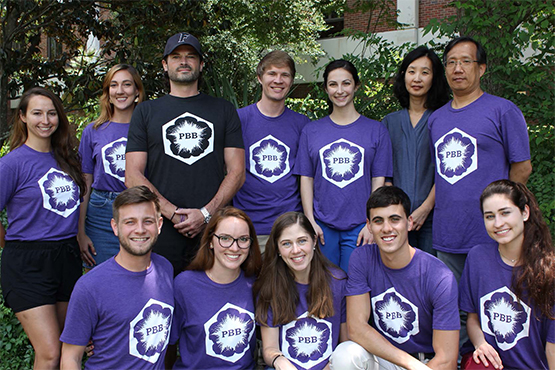Dr. Thomas A. Colquhoun
Associate Professor / Plant Biotechnology

Thomas A. Colquhoun holds the position of Associate Professor in the Environmental Horticulture Department at the University of Florida with a 90% research appointment. Current research has a strong focus on plant biotechnology with two main principles: elucidation and manipulation of plant volatile compound biosynthesis, basic and applied interactions of plant produced stimuli with animals. These principles are achieved utilizing molecular, biochemical, metabolomic, genetic, psychophysical, and psychological approaches. Specific topics include the molecular control of flower opening, biochemical pathways leading to benzenoid synthesis in plants and microbes, abiotic factors influencing plant volatile production, the affect plant volatile compounds have regarding a gustatory and/or olfactory experience in animals, and the cognitive perception of plant products by humans. Graduate and undergraduate mentoring and research training is of highest priority. Dr. Colquhoun’s lab has established sound relationships with interdepartmental, intradepartmental, national, and international collaborators.
-
RESEARCH
Comprehensively, my research interest is grounded in the concept of manipulating plant based stimuli with the ultimate goal of increasing intrinsic value in the direct interactions between plants and animals. Primary focus is the elucidation and engineering of plant volatile organic compound biosynthesis and emission. Thousands of plant volatile organic compounds have been identified and are generally classified into four major groups: terpenoids, phenylpropanoids, fatty acid derivatives, and amino acid derivatives. Subsets of these volatile chemicals are found in any given plant species, and therefore, plant volatiles are generally thought of as secondary metabolites. Plant volatile production occurs in many plant tissues including leaves, flowers, fruits, and roots with biological and ecological functions relating to pollinator attraction, seed dispersal, inter- and intra-plant communication, fruit ripening, and defense. A number of genes associated with plant volatile biosynthesis have been identified, cloned, characterized, manipulated through traditional breeding efforts, and modified using genetic engineering approaches. Additionally, complex metabolic pathways for the production of a limited number of volatile compounds have been explored in plants like petunia and tomato.
Petunia x hybrida cv ‘Mitchell Diploid’ (MD) is a model system for basic research characterizing floral volatile organic compound regulation and biosynthesis. The floral fragrance bouquet of MD is dominated by approximately 10 volatile organic compounds classified as benzenoids and phenylpropanoids. Through functional genetic analyses, many of the volatile compounds have been removed or reduced from the MD floral fragrance profile via transgenically silencing regulatory and/or biosynthetic genes. The resulting transgenic plant lines have not only been utilized to ascribe gene functions and clarify enzyme positions in biochemical pathways, but in other more applied ways, including field trials where plant-insect interactions were monitored among five different transgenic petunia lines. Through collaboration with Dr. Ian Baldwin from the Max Planck Institute for Chemical Ecology, this study provided solid evidence for individual volatile chemical functions in regard to the plant’s interaction with the environment. In brief, MD flowers produce volatile chemicals that attract both insect pollinators (facilitates sexual reproduction) and insect florivores (physically consume flower tissue such as male sexual organs). However, MD flowers also produce volatile chemicals that defend against the florivore insects.
In contrast to plant-insect volatile mediated interactions, MD flowers lacking normal methyl benzoate (predominant volatile chemical of MD floral fragrance) levels have a distinct, detectable change in odor which 80% of human olfactory panelists were able to distinguish from control flowers. The human olfactory system is a sensory network designed to identify volatile chemicals. The anatomy of this olfactory network includes the olfactory epithelium, the olfactory bulb, the olfactory cortex, and orbitofrontal cortex. Volatile compounds reach the olfactory receptors by two routes. Sniffing (say a flower) brings volatile compounds from the outside world into the nose where they stimulate the olfactory receptors at the top of the nasal space (orthonasal olfaction). When foods (say a tomato) emitting odorants are chewed and swallowed, those odorants are forced up behind the palate and into the nasal space from the back (retronasal olfaction). The brain integrates taste and retronasal olfaction to create flavor. Like numerous aspects of human sensory physiology and cognitive behavior, the sensory experience of an individual human does not invariably equate to the sensory experience of another individual. Most commonly used sensory and hedonic scales (like the Natick 9-point scales used in the food industry and the 10-point pain scale used in medical industry) lack the ability to compare intensities across groups of human subjects. Collaborative research with Dr. Linda Bartoshuk from the UF College of Dentistry aimed at averting this phenomenon is currently underway and the resulting scale (gLMS) has been deployed in large-scale psychophysics experiments pertaining to tomato, strawberry, and blueberry flavor preferences of humans.
Many fruits produce volatile chemicals of specific blends coinciding with the later stages of ripening. The senses of gustation and olfaction directly sample the chemicals present in foods like: sugars, acids, and volatiles. The division of olfaction into orthonasal olfaction and retronasal olfaction led to the discovery that these project to different brain areas for processing and are thus most likely separate functions. Of special importance, retronasal olfaction and taste project to the same brain areas and are integrated to produce flavor. This integration has a remarkable consequence, taste and retronasal olfaction can intensify one another. Ripening of fruit is often associated with the accumulation of various sugars, organic acids, and increased emission of aroma compounds. These metabolites are primary sensory elicitors of taste and olfaction, which attenuate the perception and hedonics of flavor.
To better understand this plant-human interaction, cultivated strawberry, Fragaria x. ananassa, is used for basic and applied research characterizing berry volatile organic compound (approximately 300 strawberry volatiles) biosynthetic pathways and how these volatile compounds interact with humans and flavor. Through a collaborative research approach with Dr. Kevin Folta and Dr. Vance Whitaker from the UF Horticultural Sciences Department, we have been able to identify volatile compounds as key contributors to overall fruit flavor perception. By analyzing many different biochemical constituents of numerous strawberry cultivars, interpretation of human psychophysical responses to eating these strawberry cultivars (Dr. Charles Sims’ consumer taste facility) using Dr. Bartoshuk’s gLMS scaling techniques, and employing multivariate statistical approaches, individual biochemical components of strawberries that influence flavor become clear targets for traditional strawberry breeding programs. Some of these volatile compounds not only convey flavor information, but function as a sweetener without the contribution of sugars.
Knowing volatile compounds are important to flavor and sweetness, the question arose as to whether we could modify the content or overall amount of volatile compounds using a not intrusive method. It was quickly discovered that a LED-based light platform could actually control plant growth, development, flavors and nutraceutical content with treatment of specific wavelengths and duration of light. For example, the level of important flavor volatiles has been manipulated in tomatoes, strawberries, blueberries, basil, cilantro, and even petunia flowers using this specific wavelength and duration of light approach. The use of specific wavelengths and treatments of light to modify the way our food crops taste and the nutrition we receive from eating them will be enormously impactful and may stimulate greater consumption of healthy foods like fruits and vegetables.
In a related but seemingly more abstract facet of research, the concept of Mind Genomic® is used to understand a plant consumer’s desire for specific plant products. This allows for an informed and directed approach to plant biotechnology. Dr. Howard Moskowitz from Moskowitz Jacobs Inc. has enabled the usage of his proprietary web-based software called IdeaMap®. This software is a data collection system that allows for the analysis of human subjects’ interest toward individual elements of a certain product or experience without introducing cognitive bias. We can objectively assess the impact that individual elements of a product have on potential purchasing behavior, as well as general affective states of human subjects. Therefore, we can focus on modifying plant traits, identified through this analysis, which will provide better benefit to the consumer.
In short, I am interested in a thorough understanding of the mechanisms involved in the regulation and production of plant volatile organic compounds, the physical properties and behaviors of volatile chemicals in mixtures, sensory concepts behind olfactory receptor recognition of specific volatile compounds, the neurophysics and neurobiology of signal transduction stemming from the olfactory receptor, and the overall hedonic response and cognition of flavor. Employing psychophysics, neuroscience, genetics, molecular biology, biochemistry, and traditional plant breeding has been and will continue to generate plant products with increased efficacy in regard to the plant-animal interaction.
Research Synopsis
I. Floral Volatile Biosynthesis and Regulation - Dicot/Monocot Petunia/Lilium
Characterize biosynthesis - genetic, molecular, and biochemical
Identify regulation – cis/trans, mechanisms, and environmental stimulus
II. Plant Volatile Contribution to Flavor – Fruits/Herbs
Tomato/Strawberry/Blueberry/Peach/Basil
Characterize molecular profile – genetic, biochemical, metabolic
Measure of human perception – psychophysics, cognitive psychology
III. Environmental Manipulation of Plants
Light/Microbiome/Animal Interaction
Characterize molecular profile – genetic, biochemical, metabolic
Identify enhanced environment – create enhanced plant product
IV. Psychophysics
Plant/Human
Unbiasedly identify human perception of plant products – psychophysics, cognitive psychology
Characterize molecular potential of plant germplasm – genetic, biochemical, metabolic
Create enhanced plant product – conventional breeding, genetic engineering
-
TEACHING
HOS6931: Graduate Seminar
This course is a series of graduate student seminars focusing on the development of multimedia oral presentations on topics pertaining to individual student research and/or areas of interest.
-
EDUCATION
- University of Florida Assistant Professor Nov. 2011
- University of Florida Assistant Instructor Jan. 2010
- University of Florida Plant Molecular and Cellular Biology Ph.D. Dec. 2009
- Minnesota State University Moorhead Biology B.A. Dec. 2004
-
PUBLICATIONS
HIGHLIGHTED PUBLICATIONS
- Strawberry flavor: diverse chemical compositions, a seasonal influence, and effects on sensory perception
- Light modulation of volatile organic compounds from petunia flowers and select fruits
- Petunia flowers solve the defence/apparency dilemma of pollinator attraction by deploying complex floral blends
-
RECENT SERVICES AND HONORS
- Recognized – UF/IFAS High Impact Research Publication Award (2014)
- Nominated – UF Homecoming Outstanding Mentor of Undergraduate Research Award (2012)

